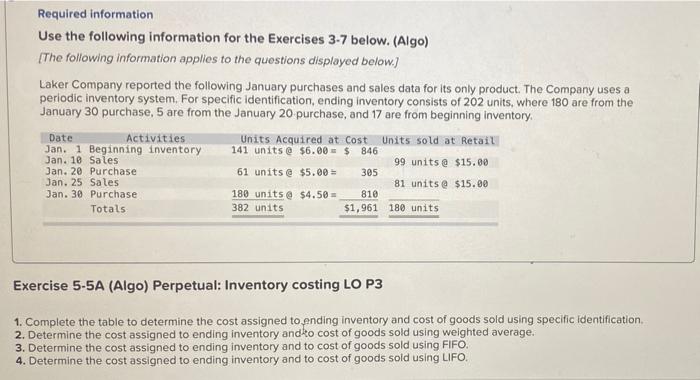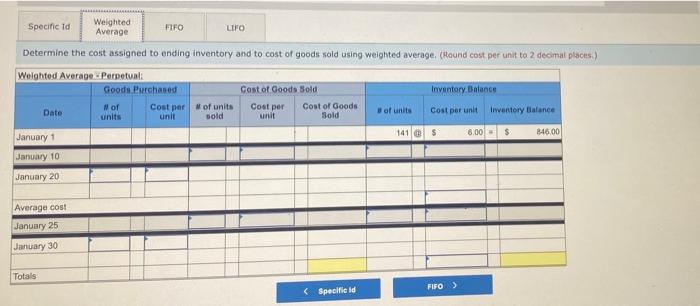Answered step by step
Verified Expert Solution
Question
1 Approved Answer
the blue flags is what box needs to be filled in, please if you can use the same format to answer the questions. Required information
the blue flags is what box needs to be filled in, please if you can use the same format to answer the questions. 




Required information Use the following information for the Exercises 3-7 below. (Algo) [The following information applies to the questions displayed below.) Laker Company reported the following January purchases and sales data for its only product. The Company uses a periodic inventory system. For specific identification, ending inventory consists of 202 units, where 180 are from the January 30 purchase, 5 are from the January 20 purchase, and 17 are from beginning inventory Date Activities Units Acquired at Cost Units sold at Retail Jan. 1 Beginning inventory 141 units @ $6.00 = $ 846 Jan. 18 Sales 99 units @ $15.00 Jan. 20 Purchase 61 units @ $5.00 = 305 Jan. 25 Sales 81 units @ $15.00 180 units @ $4.50 Totals 382 units $1,961 180 units Jan. 30 Purchase 810 Exercise 5-5A (Algo) Perpetual: Inventory costing LO P3 1. Complete the table to determine the cost assigned to ending inventory and cost of goods sold using specific identification 2. Determine the cost assigned to ending inventory andko cost of goods sold using weighted average. 3. Determine the cost assigned to ending inventory and to cost of goods sold using FIFO. 4. Determine the cost assigned to ending inventory and to cost of goods sold using LIFO. Complete this question by entering your answers in the tabs below. Specifica Weighted PIFO LIFO Average Complete the table to determine the cost assigned to ending inventory and cost of goods told using specific identification Specific Identification Available for Sale Cost of Goods Sold Ending Inventory Ending Activity Purchase Date Cost Per #of units Ending COGS Inventory Cost Per Unitventory Cout sold of units Cost Per Um Unit Units Jan 1 Jan 20 Jan, 30 Beginning inventory Purchase Purchase 141 61 180 382 0 $ 0 0 Weighted Average Specific Id Weighted FIFO Average LIFO Determine the cost assigned to ending inventory and to cost of goods sold using weighted average (Round cost per unit to 2 decimal places.) Weighted Average Perpetual Goods Purchased Cast of Goods Bold Inventory Balance Date of Cost per Mof units Cost per Cost of Goods units unit of units Sold Cost per unit Irwantory Balance unit January 1 141 S $ 346,00 January 10 Sold 6.00 January 20 Average cos! January 25 January 30 Totals Determine the cost assigned to ending inventory and to cost of goods sold using FIFO. Perpetual FIFO: Date Goods Purchased # of units unit Cost per Cost of Goods Sold # of units Cost per Cost of Goods sold unit Sold Inventory Balance unit Inventory Balance # of units Cost per January 1 141 @ $ 6.00 = $ 846.00 January 10 January 20 January 25 January 30 Totals Determine the cost assigned to ending inventory and to cost of goods sold using LIFO. Perpetual LIFO: Goods Purchased # of units unit Cost per Cost of Goods Sold # of units Cost per Cost of Goods sold unit Sold Inventory Balance Inventory Balance unit Cost per Date # of units 141 @ January 1 $ $ 6.00 = 846.00 January 10 January 20 January 25 January 30 Totals 




Step by Step Solution
There are 3 Steps involved in it
Step: 1

Get Instant Access to Expert-Tailored Solutions
See step-by-step solutions with expert insights and AI powered tools for academic success
Step: 2

Step: 3

Ace Your Homework with AI
Get the answers you need in no time with our AI-driven, step-by-step assistance
Get Started


